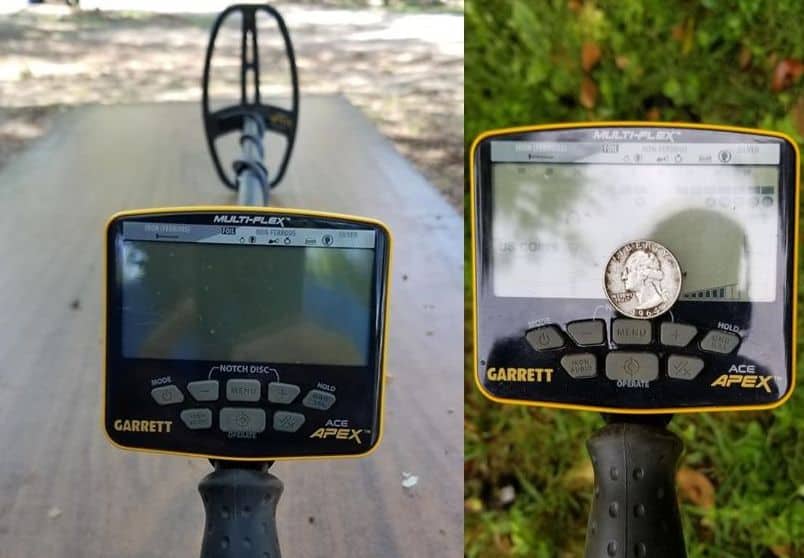
Having a metal detector with great discrimination capabilities is not enough to be able to filter trash and find valuable targets! Indeed, it is also very important to know how to properly set discrimination to make the most out of your machine …
In this article, I give some basic but very important steps to follow in order to set the discrimination feature the right way.
What does metal detector discrimination mean?
Discrimination is the ability of any metal detector to identify the buried targets based on the conductive and/or ferrous properties of the metal.
By correctly identifying what type of metal a buried target is made up of, you can take a call on whether to dig it up or consider it as junk and move ahead.
This action of eliminating or notching out certain types of metal targets is helpful because it allows the detector to only display a visual or audio cue whenever the desired target is located.
If the detectorist is searching at a place where there are a lot of junk items or trash like iron nails, the detectorist can decide to discriminate out the iron targets so as to save time from having to dig up the nails. They can then focus on finding the more desirable targets.
How to properly set your metal detector discrimination?
Many of the older detectors only come with a dial, which, while still alerting for the metals, many older detectors only shows the user what type of metal the target might be.
By the way, if you have issues setting your metal detector discrimination or any other issues, then you should have a look at this metal detector troubleshooting guide. You will find it really useful …
Even older metal detectors come with a dial associated with numbers that signify the signal’s strength.
This number can then be matched with the general signal strengths of various objects and types of metal.
Many metal detectors come with a coin mode which, when activated, ensures that your metal detector will search for coin-shaped targets and eliminate iron targets like iron nails.
So you will hear a certain pitch, usually a high pitch sound, to indicate that you have found a coin object.
This helps the detectorist save time and effort by not digging up trash and junk items like rusty nails and pulling tabs.
Like the coin mode, many metal detectors have other discrimination mode settings like relics, jewelry, and custom.
There is also an all-metal mode that does not discriminate at all between the metals. In this mode, the detector will detect everything it comes in contact with.
Most detectors come with different +/- sets of buttons. One controls sensitivity, while one controls discrimination and one that controls both by simplifying the settings to the type of target you are looking to find.
The custom mode of discrimination lets a user create their own desired customized profile for discrimination and sensitivity.
The Zero mode allows detection for all types of metal, essentially just discriminating against zero metals. This lets you choose between eight different sensitivity levels as well.
Example: Metal Detector with good discrimination

Since its launch in July 2020, the Garrett ACE Apex (Check it Here at Amazon) is a multi-frequency metal detector.
Weighing just 1.13 kg (2.5 pounds), this is a lightweight detector that has the multi-frequency Multi-Flex technology of Garrett, that also boasts of a hybrid audio system, a rechargeable lithium-ion battery, and a high-resolution ground balance that makes it easier than ever to identify various valuable targets.
The ground balance feature in this top-end metal detector is excellent, and the machine performs correctly due to the high-resolution 175 points of ground balance resolution that fits all-terrain types, from saltwater to ferrous ground.
The 175-point high-resolution ground balance allows this detector to adapt quickly to challenging soil conditions, moving effortlessly from highly mineralized soil to saltwater.
At the same time, the machine has hi-resolution discrimination. The Notch Discrimination feature of the ACE Apex metal detector allows the user to discriminate easily between the different metal types with 20 levels of discrimination, out of which 8 of them are for iron.
Does metal detector sensitivity setting impact its discrimination?
While discrimination of the metal detector focuses on processing signals to determine what is the object’s metallic composition, sensitivity settings in a metal detector is about changing how strong or weak a signal your detector will accept.
This means that by increasing the sensitivity levels of your detector, you may be able to detect objects that are non-ferrous or buried deeper in the ground.
While this can be used to some degree to exclude some types of metals, it is not nearly as comprehensive or easy to use as the discrimination function of the detector. This is why the two functions are separate.
If you keep your sensitivity settings at the highest, then the detector will not be able to discriminate much between the different types of metals, and it will start giving an alert for junk items as well.
Does frequency influence metal detector discrimination capabilities?
The frequency of a metal detector is one of the main characteristics that determines how well targets can be detected.
Generally, a single frequency detector that transmits at a high frequency will be more sensitive to small targets and a single frequency detector that transmits at low frequencies will give more depth on large targets. A detector’s frequency settings does not have much of an impact on the discrimination capabilities.
Does Coil Size & Type influence metal detector discrimination capabilities?
The size of a coil can influence the detection depth and sensitivity of a metal detector, but it doesn’t have much of an impact on its discrimination properties.
The larger the coil, the more ground you can cover and the deeper it can detect. But, larger coils also have less sensitivity to smaller targets and a greater susceptibility to Electro Magnetic Interference (EMI), meaning you may have to notch that sensitivity right down, depending on the interference of the location.
On the other hand, smaller coils have greater sensitivity to smaller, shallow targets and are less susceptible to EMI.
What is notch discrimination on a metal detector?
Notch discrimination on a metal detector lets the user either accept or reject certain ranges of targets based on their conductivity.
You can reject individual notch segments, specific groups of notches, or even randomly select the segments you want to reject.
With notch discrimination, you choose to reject the notch that indicates pull tabs or iron nails and set the notch that represents nickels to be accepted.
For many users, notch discrimination lets you cherry-pick a site more thoroughly than just variable discrimination.
What does S Cap mean on a metal detector?
S-Cap is one of the target ID categories on certain detectors. Older screw caps from glass bottles, square nails, and steep objects that exhibit both electrical and ferromagnetic properties are categorized under S-Cap. You can program your detector to reject or accept such items.
Final Thoughts …
If you are a beginner then don’t worry too much about discrimination, just start by digging for everything and take notes whenever you find something (even if it is junk) by noting the tones intensity and the VDI number …
After many hunts, you will get a feel on when you should activate the discrimination feature and when you should not.
